In the intricate tapestry of the natural world, some creatures have honed their survival skills to perfection, becoming true masters of nature’s camouflage. With the ability to blend seamlessly into their surroundings, these animals have evolved unique adaptations that render them nearly invisible to both predators and prey. From the depths of the ocean to the heart of lush forests and arid deserts, join us on a journey to discover the remarkable stories of these masters of disguise who have unlocked the secrets of nature’s most ingenious art form: camouflage.
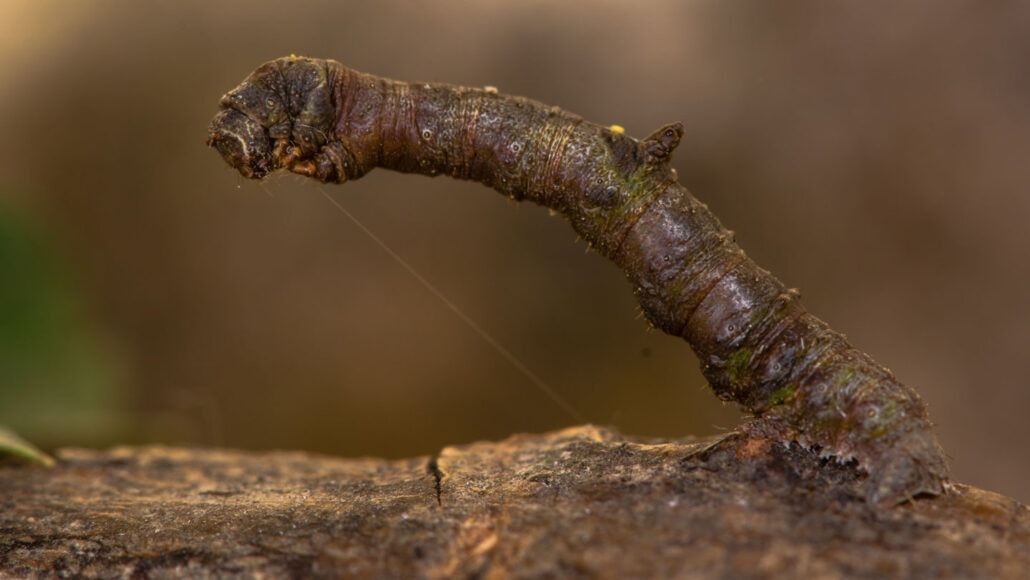
Brimstone Moth Caterpillar
Brimstone moth caterpillars are fascinating creatures with a unique fashion sense. They come in two distinct color variations: a vibrant lime-green and a more subdued brown. This dual wardrobe allows them to effectively camouflage themselves within their specific environments, showcasing their adaptability in different foliage. These caterpillars are masters of blending in rather than changing color, demonstrating their clever survival strategy in the natural world. Keep a watchful eye, for these stylish caterpillars know how to choose the perfect outfit to stay hidden in plain sight in your garden.
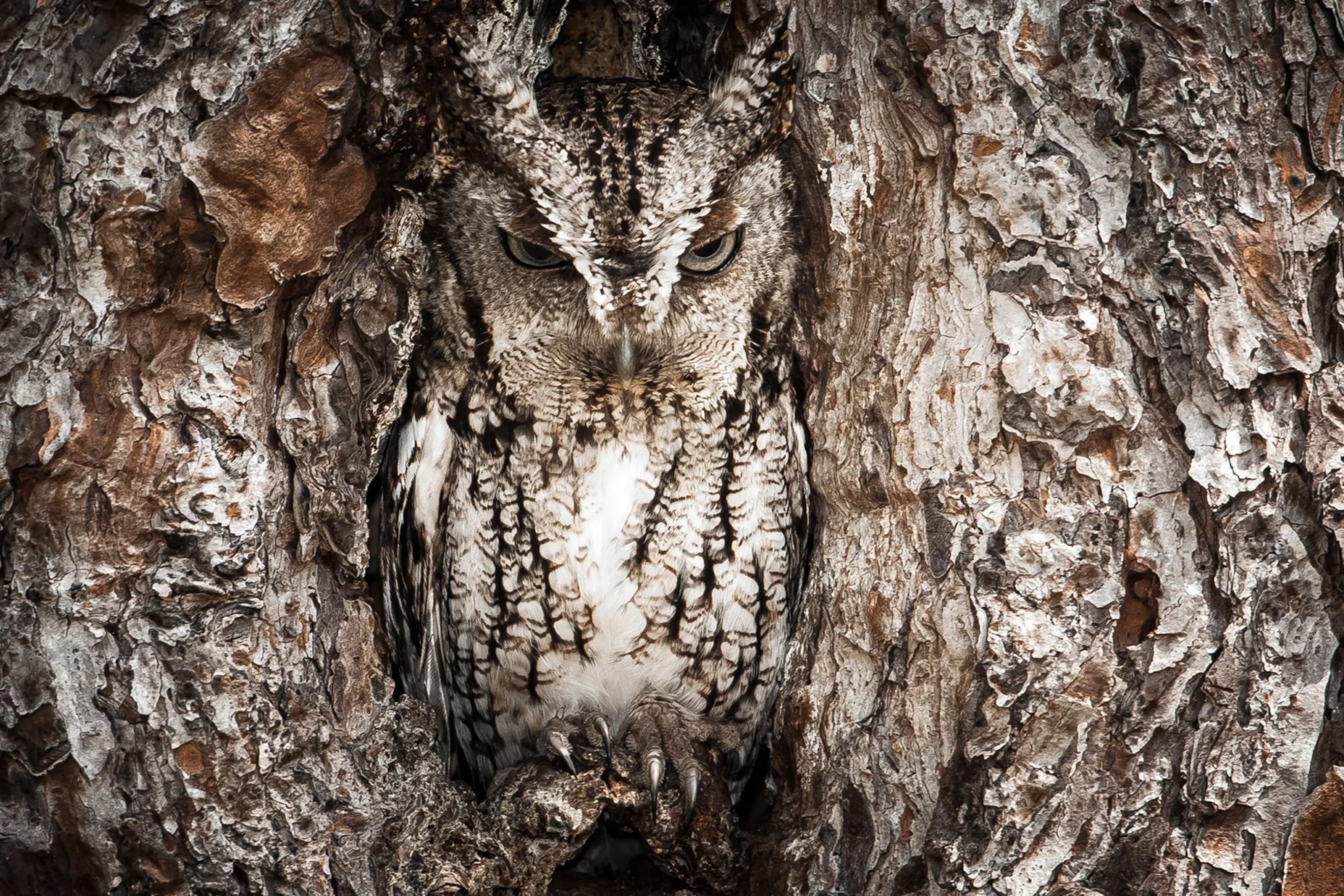
Eastern Screech Owl
Eastern screech owls are enchanting nocturnal birds known for their small size but big personality. With plumage ranging from a vibrant reddish-brown to a cool gray, these owls exhibit a remarkable diversity of colors. This adaptability allows them to blend seamlessly into their wooded habitats, making them elusive and expertly camouflaged hunters. Despite their diminutive stature, their haunting screeches can send shivers down your spine during a moonlit night. So, keep your ears tuned and your eyes peeled, as encountering these captivating creatures can be a thrilling and mysterious experience in the world of avian wildlife.
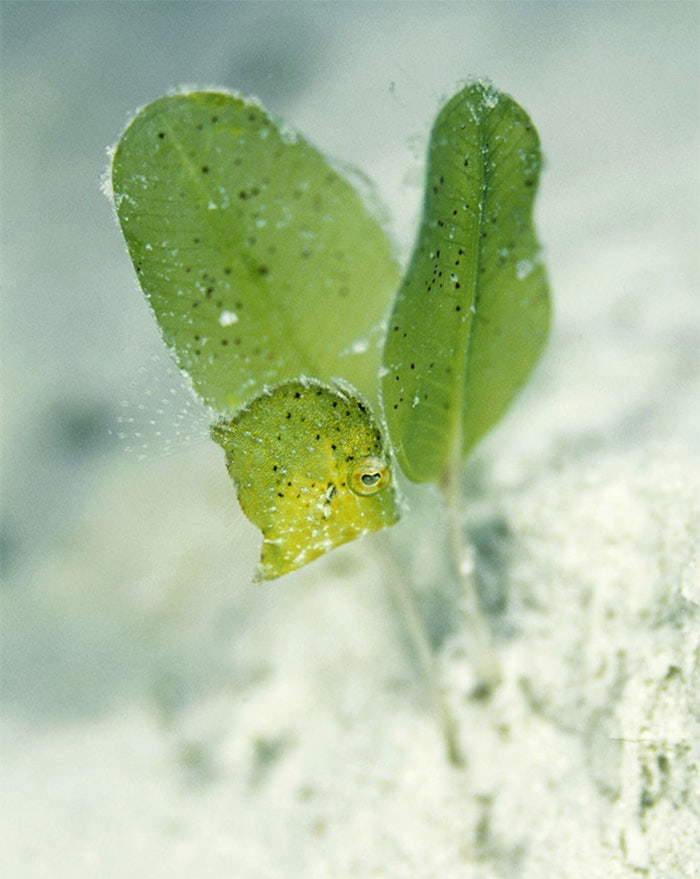
Southern Pygmy Leatherjacket
The Southern Pygmy Leatherjacket fish stands out for its diminutive size and distinctive rounded shape. What makes this fish even more intriguing is the absence of a secondary locking spine in its dorsal spine, allowing it to be easily depressed. These unique characteristics make them easily distinguishable in their underwater world. Found abundantly in the southern states, these small leatherjackets thrive in seagrass and brown algal habitats, where they blend seamlessly with their surroundings.
As creatures of the night, they exhibit a peculiar behavior of sleeping while securely attached by their mouths to seaweed fronds, a remarkable adaptation that adds to their mystique in the aquatic realm. In addition to their unique physical features and nocturnal habits, Southern Pygmy Leatherjacket fish play an essential role in the marine ecosystem. They are known to feed on small invertebrates, algae, and detritus, contributing to the balance of their underwater habitats. Despite their small stature, these fish are a vital part of the intricate web of life in seagrass and brown algal environments, highlighting the significance of even the tiniest creatures in maintaining the health and diversity of our oceans.
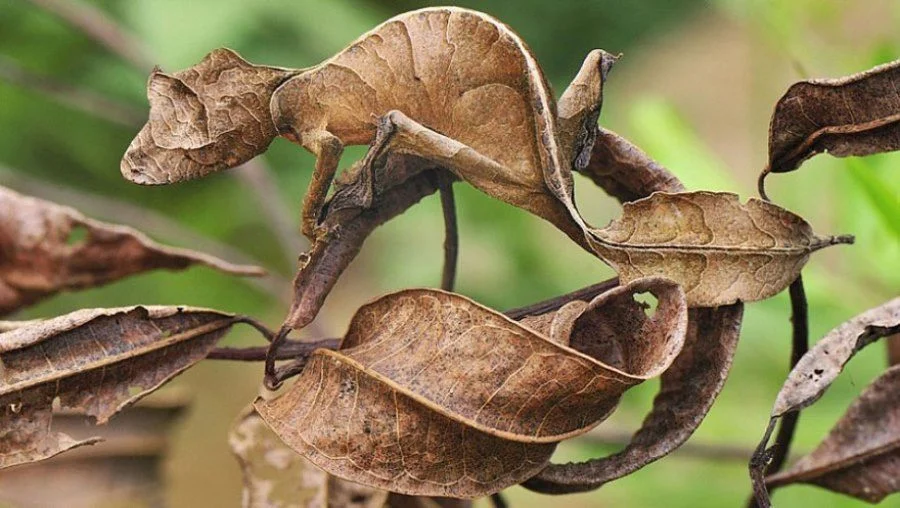
Satanic Leaf-Tailed Gecko
The Satanic Leaf-Tailed Gecko, native to the lush rainforests of Madagascar, is a true master of camouflage. With its astonishing leaf-like appearance, it’s nearly impossible to distinguish from the surrounding foliage. These geckos possess an uncanny ability to mimic dead leaves, complete with intricate patterns, irregular edges, and even simulated bite marks, making them virtually invisible to predators and unsuspecting prey.
Their body shape and coloration are remarkable examples of evolution at work. They have flattened bodies with leafy appendages that further enhance their disguise, making them blend seamlessly with the forest floor or tree branches. Satanic Leaf-Tailed Geckos are usually brown or gray, but their coloration can vary, matching the specific tree or environment they inhabit. These geckos are relatively small, measuring around 8 to 9 inches in length. They are primarily nocturnal, emerging under the cover of darkness to hunt for insects and other small invertebrates. Their large, lidless eyes are adapted for low light conditions, aiding in their nocturnal hunting endeavors.

Hobart’s Red Glider Butterfly
Hobart’s Red Glider, scientifically known as Cymothoe hobarti, is a captivating species of butterfly belonging to the Nymphalidae family. This exquisite butterfly is native to the rich and diverse ecosystems of the Democratic Republic of the Congo, the Central African Republic, Uganda, Kenya, and Tanzania. It thrives in a habitat range that spans from lowland to sub-montane forests, where it has honed its remarkable camouflage skills. Hobart’s Red Glider exhibits a distinctive appearance, with a brilliant crimson hue on the upper side of its wings.
This remarkable adaptation allows it to disappear effortlessly against foliage of similar red hues.. These butterflies are known for their graceful flight and are primarily arboreal, spending much of their time in the treetops where they feed on nectar from various flowers. Encountering a Hobart’s Red Glider Butterfly in the wild is not only a testament to the beauty of nature but also a reminder of the intricate ways in which species like this have evolved to thrive in their specific environments, relying on their exquisite camouflage to navigate the dense forests they call home.
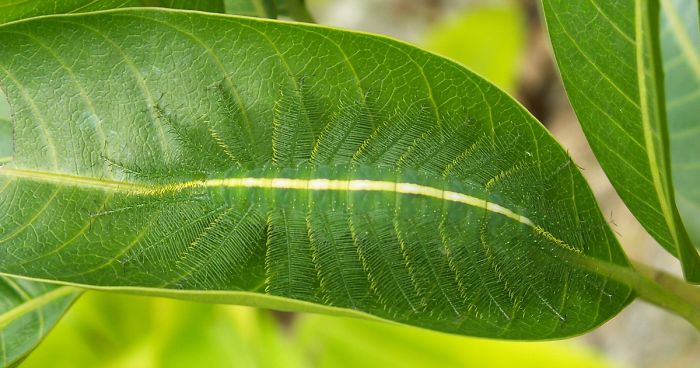 Via Bored Panda
Via Bored Panda
Common Baron Caterpillar
The Common Baron Caterpillar (Euthalia aconthea), native to the lush landscapes of India and Southeast Asia, stands out as a true master of camouflage. When it positions itself perfectly on a mango tree leaf, it is nearly impossible to spot, even if you know it’s there. This remarkable critter has evolved to blend into its preferred background so seamlessly that it sets a high bar for camouflage in the animal kingdom.
These caterpillars exhibit a fascinating adaptation to their environment. Their bodies sport a stunning blend of greens and browns, mirroring the intricate patterns and colors of the foliage they inhabit. Their subtle variations in color, along with their elongated shape, make them appear like a natural part of the leaf they rest upon, serving as a textbook example of nature’s genius at work. While excelling in the art of disguise, Common Baron Caterpillars also play a crucial role in their ecosystem. As they munch on leaves and undergo metamorphosis into stunning butterflies, they contribute to the intricate web of life in their habitat.
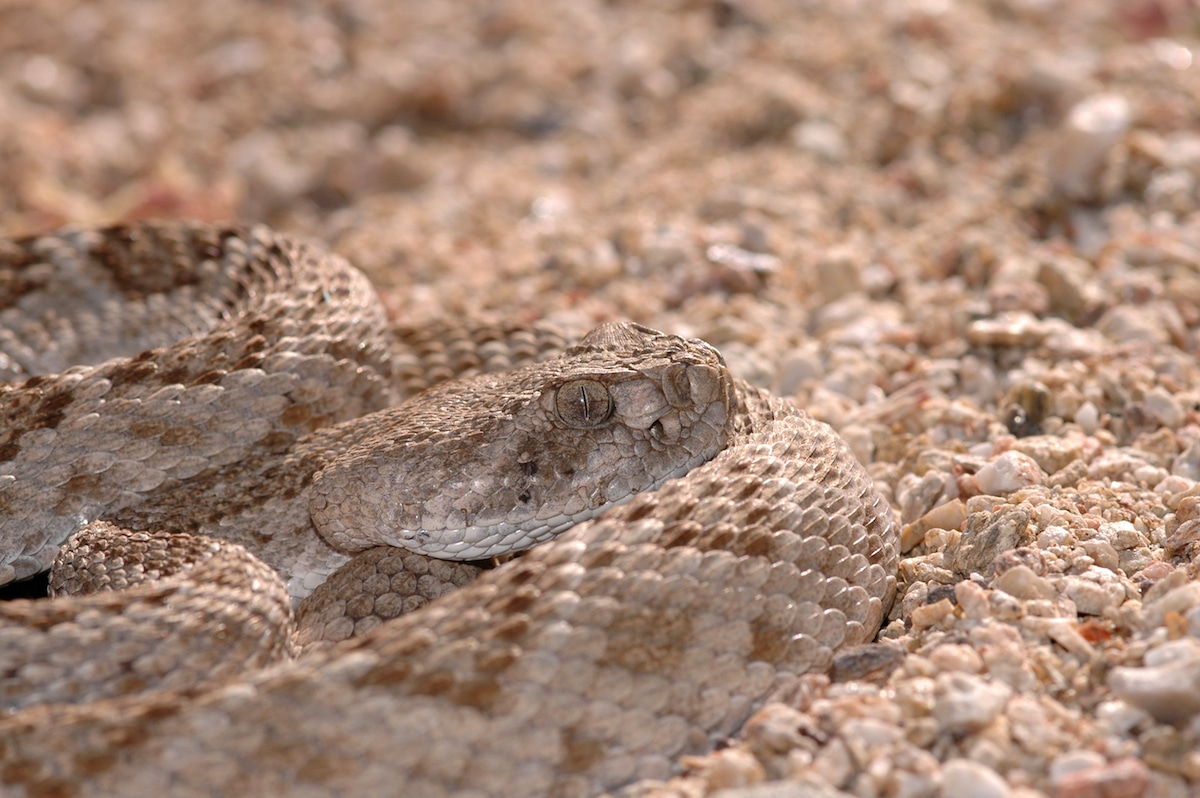
Western Diamondback Rattlesnake
The Western Diamondback Rattlesnake is an iconic and highly adaptable species of venomous snake found across the southwestern United States and northern Mexico. These formidable reptiles are known for their striking appearance and, perhaps most notably, their exceptional camouflage abilities. Western Diamondbacks have scales adorned with a distinctive diamond-shaped pattern, which perfectly blends with the arid and rocky landscapes they call home.
Their coloration typically ranges from grayish-brown to pinkish-tan, providing them with exceptional camouflage in their desert environments. This camouflage serves a dual purpose, allowing them to remain concealed from both potential predators and unsuspecting prey. Western Diamondbacks are ambush predators, patiently waiting for small mammals, birds, or even other reptiles to come within striking distance. One of their most recognizable features is the rattles on their tails, which they use to warn potential threats of their presence when threatened. These rattlesnakes are not only masters of disguise but also skilled hunters, utilizing their excellent camouflage and potent venom to secure their prey efficiently.
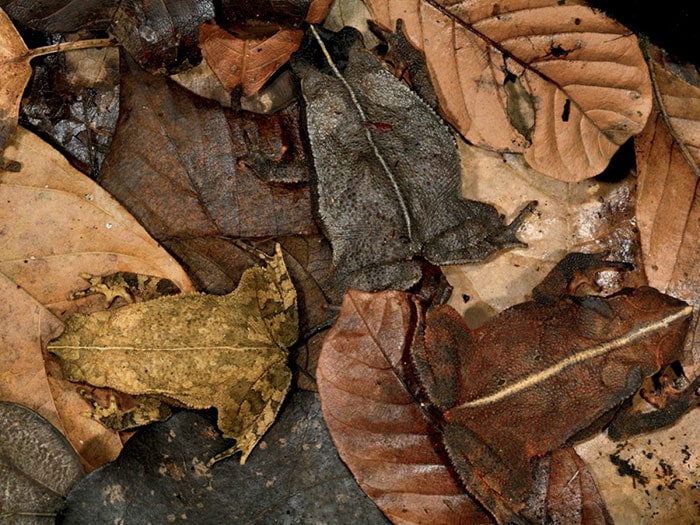
Leaf Litter Toads
Leaf litter toads, belonging to the Bufonidae family, are captivating amphibians inhabiting a range of countries, including eastern Honduras, Nicaragua, Costa Rica, Panama, Colombia, northwestern Venezuela (Serranía del Perijá), and northwestern Ecuador. These toads display an impressive altitude range, from sea level to elevations reaching 1,300 meters (approximately 4,300 feet). They are primarily nocturnal creatures and thrive in the lush settings of primary tropical moist forests and submontane humid forests, where they find refuge amidst the fallen leaves on the forest floor.
During their breeding seasons, leaf litter toads make their way to the banks of small streams and large rivers. Their distinctive ability to seamlessly blend into the leaf litter serves as both a defense mechanism against predators and a means to locate their favored prey. Speaking of diet, these toads have a particular fondness for ants, forming the primary component of their diet. This dietary preference plays a vital role in regulating ant populations, thereby contributing to the ecological equilibrium within their habitat. Leaf litter toads are known for their adaptability, thriving even in disturbed areas while maintaining a close association with forested regions. Breeding activities predominantly occur in rocky pools along the forest stream edges, underlining their essential role in preserving the health and balance of these unique ecosystems.

Wrap Around Spider
Wrap-around spiders, members of the Dolophones genus, are fascinating arachnids with 17 endemic species found in Australia and parts of Oceania. These remarkable spiders possess a unique ability to flatten themselves against tree branches, thanks to their distinctive body shape. Their inverted-dish-shaped abdomen allows them to snugly hug the curves of trees, aided by their fuzzy legs and an astonishing camouflage. The abdomen features oval discs arranged in a peculiar pattern, earning them the nickname “leopard spider.”
Wrap-around spiders are primarily nocturnal, springing to life in the dark to construct intricate vertical orb webs. As dawn approaches, they dismantle their webs and return to their hidden positions on branches, avoiding daylight exposure. While their presence may surprise those who unwittingly grab tree branches in the bush, the good news is that they belong to the Araneida family of orb-weavers. Although they possess venom, it’s generally not particularly harmful to humans, making encounters with these unique spiders more intriguing than dangerous in the diverse ecosystems of Australia and Oceania.
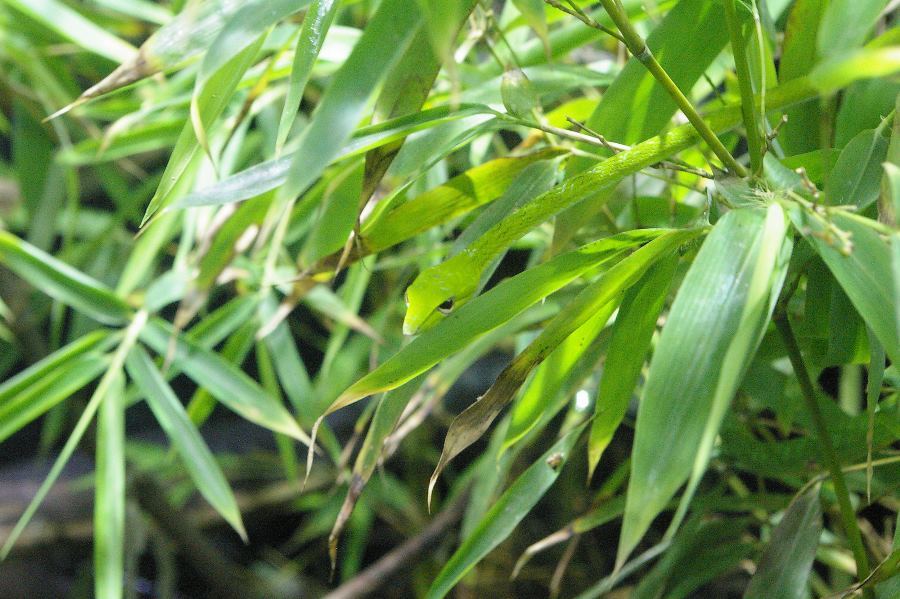
Asian Vine Snake
The Asian Vine Snake, a species of Colubrid snake, is native to Southern Asia, thriving in countries like Cambodia, Thailand, Vietnam, Singapore, and Malaysia. This snake is recognized by several common names, including the Boie’s Whip Snake, Gunter’s Whip Snake, and Oriental Whip Snake. Known for its impressive length, it can grow up to 6 feet, boasting an elongated tail that can reach nearly 2 feet. These snakes possess a relatively flat, triangular head with an extended and pointed snout, accentuating their triangular appearance.
Asian Vine Snakes are predominantly green in color with a yellow, white, or cream-colored belly, often adorned with small white and black markings along their dorsal region. In captivity, various color forms are observed. Their adaptability to diverse habitats across Southern and South-East Asia ensures healthy population levels across many regions. While they have gained popularity in the pet trade, their natural habitats continue to play a crucial role in sustaining these captivating serpents. In the wild, the Asian Vine Snake will feed on a variety of different prey. Their primary food sources consist of birds, frogs, lizards and smaller snakes. Lizards and tree frogs seem to make up a large portion of their diet.
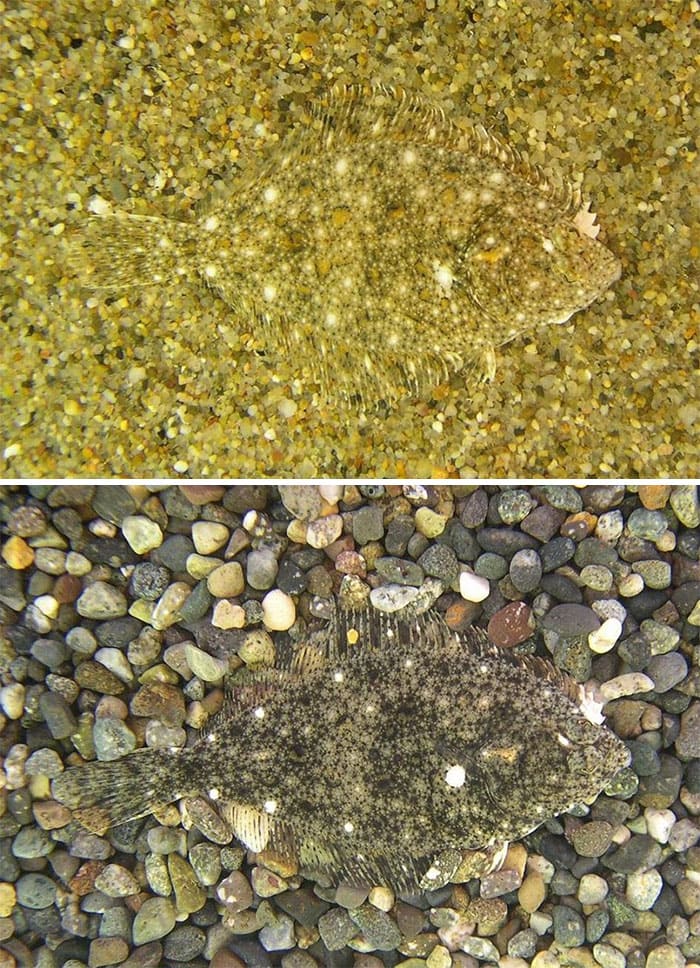
Stone Flounder
The stone flounder, like many flounders, possesses a fascinating feature known as chromatophores, specialized skin cells that hold pigments capable of changing the skin’s appearance. These remarkable cells respond to messages from the brain, allowing the flounder to adapt to its surroundings. When stone flounders swim near the water’s surface to forage, their skin becomes nearly transparent, aiding in avoiding predators lurking below. In contrast, when they venture close to the seabed, their skin can mimic the various colors and textures of the ocean floor. They are adept at resembling sand one moment and a rocky bottom the next, a survival strategy based on their environment.
In a fascinating experiment, a scientist placed a flounder against a checkerboard pattern to observe its abilities. Astonishingly, in less than a minute, the flounder’s body began to imitate the black and white squares of the gameboard, showcasing the stone flounder’s incredible adaptability and camouflage skills, which are vital for both evading predators and ambushing prey.
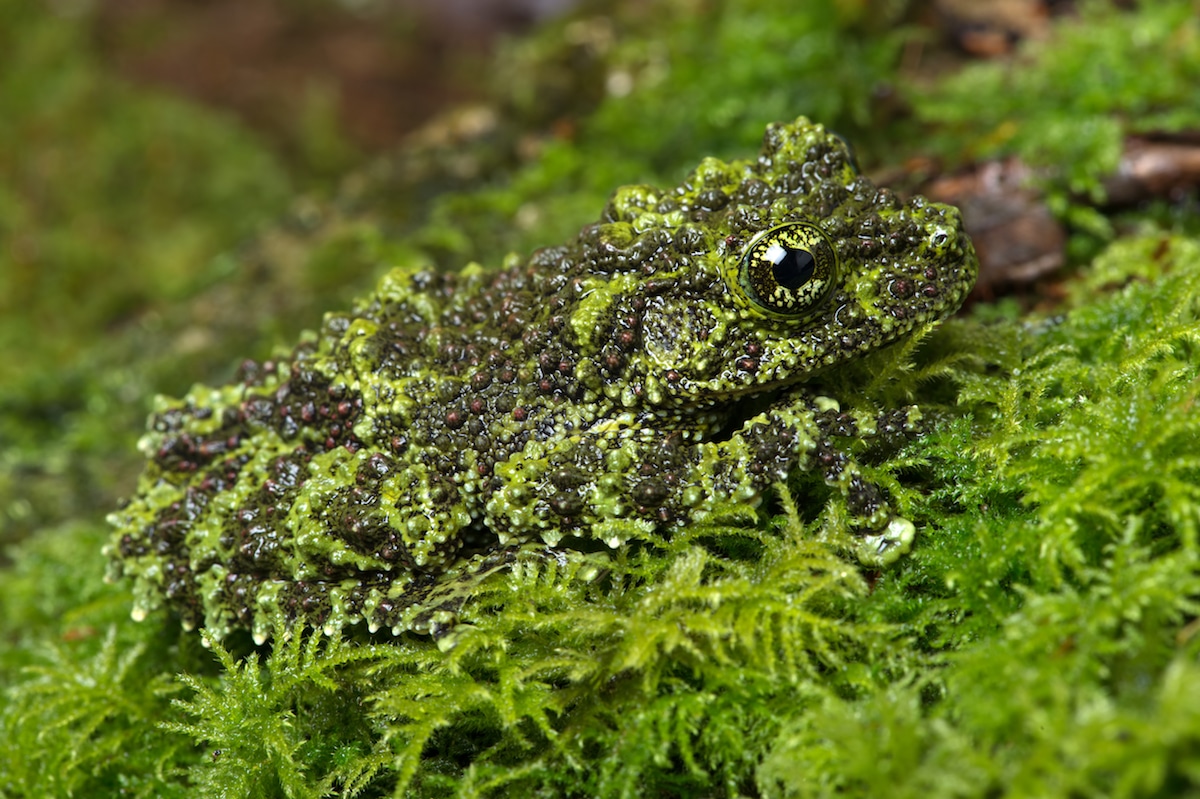
Vietnamese Mossy Frog
Vietnamese mossy frogs are unique creatures that resemble clumps of moss due to their green color, black spots, and visible tubercules and spines. They have adhesive toe pads for climbing and jumping abilities. These frogs are masters of camouflage, hiding in water basins and rocky crevices with only their eyes peeking out, making them nearly impossible to spot when stationary. They grow up to 3.5 inches, with males generally smaller and thinner than females.
These frogs are native to northern Vietnam, inhabiting flooded caves and rocky mountain stream banks. They communicate by throwing their voices over impressive distances, making them challenging to locate in the wild. Their diet includes large insects like crickets and cockroaches. Vietnamese mossy frogs breed in rock cavities above water to protect their eggs from aquatic predators. After hatching, tadpoles drop into the water below and undergo metamorphosis, becoming frogs in about three months. While their lifespan is not precisely known, it’s estimated to be around ten years. These fascinating creatures are primarily active at night and have successfully bred in human care.
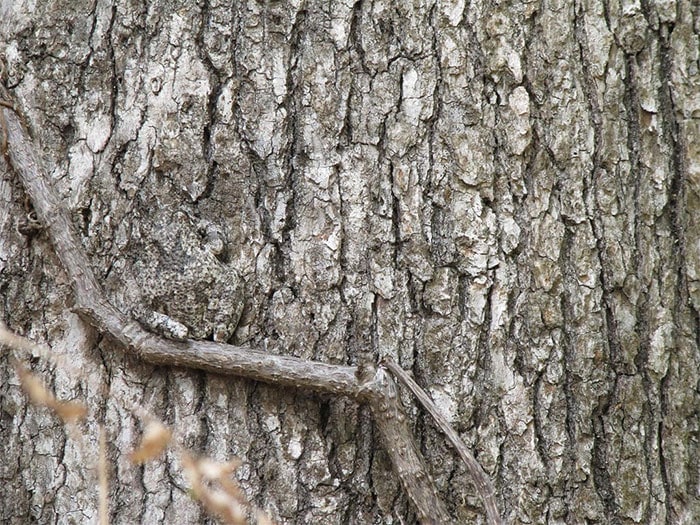
Gray Tree Frog
The Gray Tree Frog is a charming amphibian known for its remarkable adaptability and unique features. Native to North America, it is found across a wide range of habitats, from woodlands and meadows to suburban gardens. These frogs possess a cryptic gray or greenish-gray coloration, which helps them blend seamlessly with tree bark and foliage, providing excellent camouflage against potential predators. Their skin is often marked with dark blotches or patterns that further enhance their camouflage.
Gray Tree Frogs are relatively small, typically measuring around 1.5 to 2 inches in length. They have distinctive, adhesive toe pads that allow them to climb trees and other surfaces with ease. These adaptable frogs are known for their exceptional vocalizations, producing a high-pitched, melodic trill during the breeding season to attract mates. During the day, Gray Tree Frogs are often found resting on tree branches or leaves, where they remain hidden. At night, they become more active, hunting for insects and other small invertebrates.
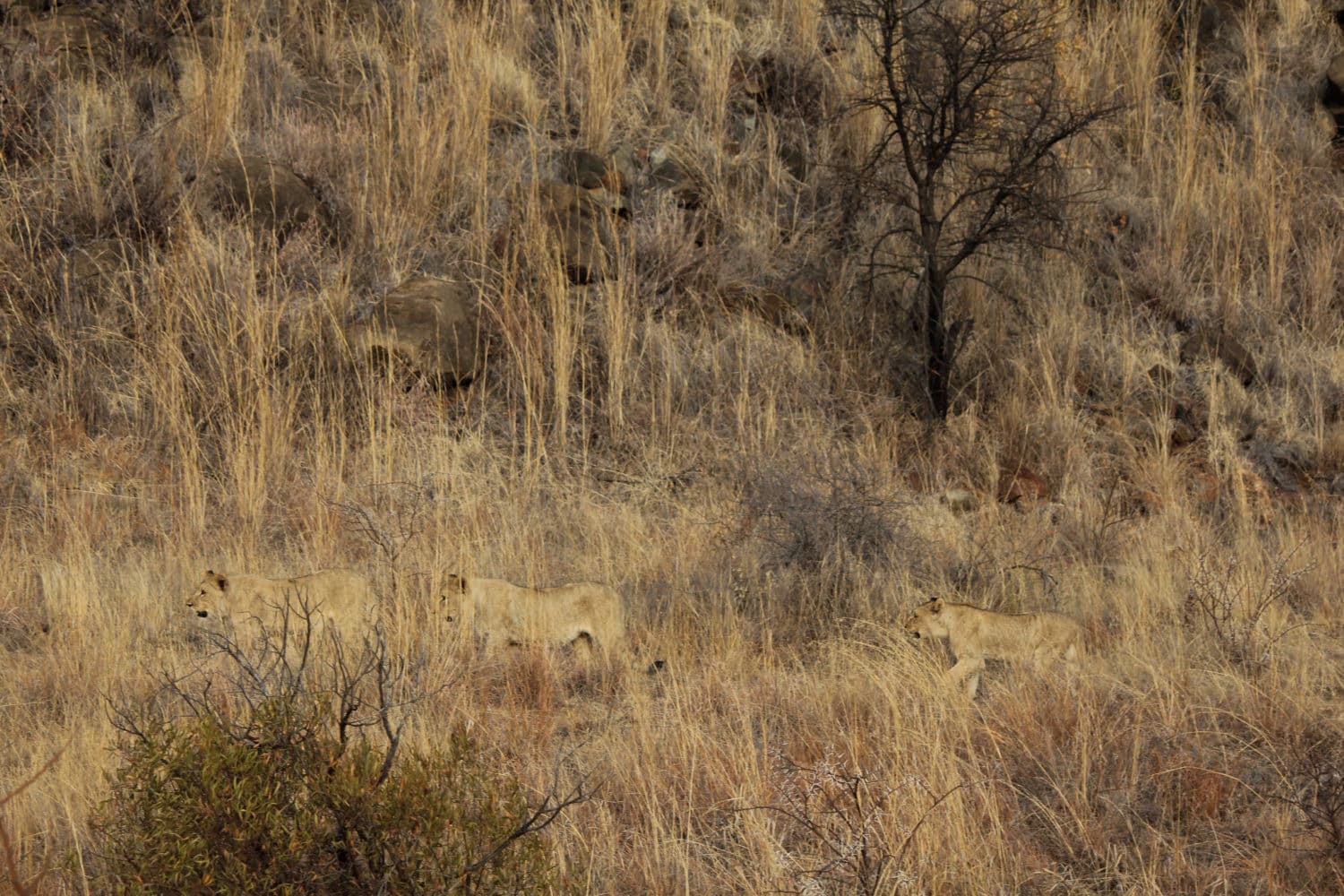
Lions
Lions, often referred to as the “king of the jungle,” are among the most iconic and formidable predators in the animal kingdom. While they are not typically associated with the kind of camouflage seen in smaller creatures, they possess a different kind of adaptation for survival. Lions have evolved to blend into their grassland and savanna habitats, where their tawny fur closely matches the hues of the surrounding landscape.
Their tawny coats help them blend into the tall, sun-drenched grasses of the African plains. When lions are crouched low in the grass, their tawny coloration makes them incredibly difficult to spot from a distance. This natural camouflage aids in their hunting strategies, enabling them to stalk prey with stealth and patience. Although lions are not the masters of intricate camouflage like some smaller animals, their ability to blend into their environment when they need to, combined with their exceptional hunting skills, makes them apex predators and symbols of power and grace in the African wilderness.
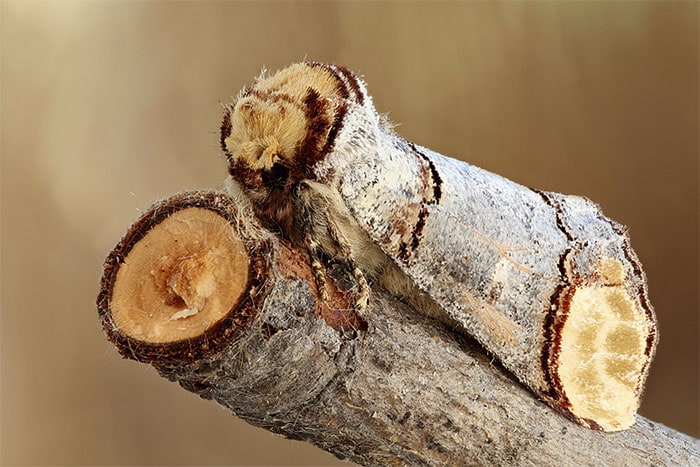
Buff Tip Moth
The buff-tip moth, a creature of the night, graces us with its presence from late May to July. You’ll often find it in your local parks, gardens, and along the edges of woodlands and hedgerows, proving itself to be quite the common visitor. But it’s not just the adult moth that’s intriguing; its caterpillars are striking in their own right. They’re large, sporting a flamboyant yellow coat, accented by a bold black head and a ring of short black stripes on each segment. These caterpillars are often social butterflies (figuratively, of course), gathering in large groups and feasting on the leaves of lime, birch, hazel, and willow trees. Occasionally, they’ll go all out and defoliate entire branches, but rest assured, they rarely cause serious harm.
When it’s time for a transformation, the buff-tip moth pupates on the ground, adopting the role of a chrysalis during the winter months. But what sets this moth apart is its knack for disguise. With wings tucked neatly against its body, it bears an uncanny resemblance to a birch twig. Its predominantly silvery-grey coloration is highlighted by a square-cut, buffy head, and a telltale buff patch at the wingtips – a clever camouflage that earns it the name “buff-tip.”
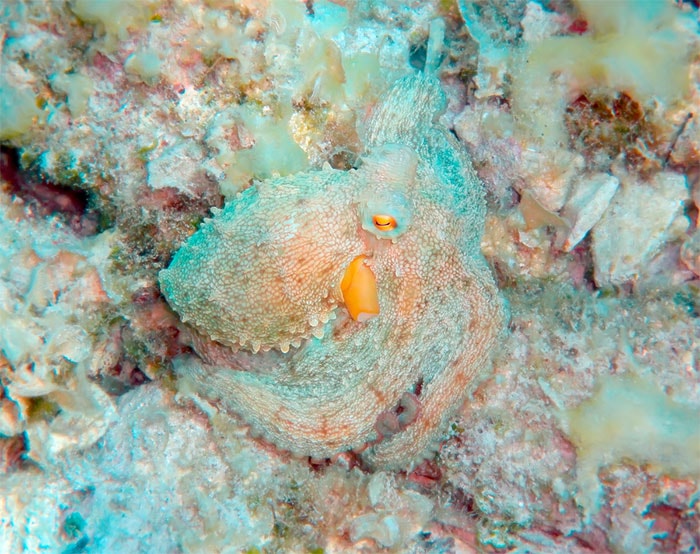
Octopus
Octopuses are undeniably remarkable creatures with an array of superpowers. They are highly intelligent and cunning, capable of incredible feats such as squeezing through tiny spaces and making daring escapes into the wild, all without the support of a backbone. Let’s dive into one of their most astonishing abilities: the art of changing color. Witnessing an octopus change color is a mesmerizing spectacle. Cephalopods, which include octopuses, squid, and cuttlefish, belong to an exclusive group of animals that possess the incredible ability to alter their color based on their activities or surroundings. This exclusive club also includes seahorses, certain amphibians, and lizards, with chameleons being a notable member.
So, how do octopuses perform this chromatic magic? It all comes down to specialized skin cells called chromatophores. These cells feature a stretchy sac known as the cytoelastic sacculus, which contains pigments in colors like red, yellow, brown, and black. When the surrounding muscles contract, they widen the sacculus, making more pigment visible on the octopus’s skin. Conversely, when the muscles relax, the sacculus shrinks, causing less pigment to show. This dynamic process allows octopuses to create an incredible range of colors and patterns, enabling them to blend seamlessly into their environment or communicate with other octopuses.
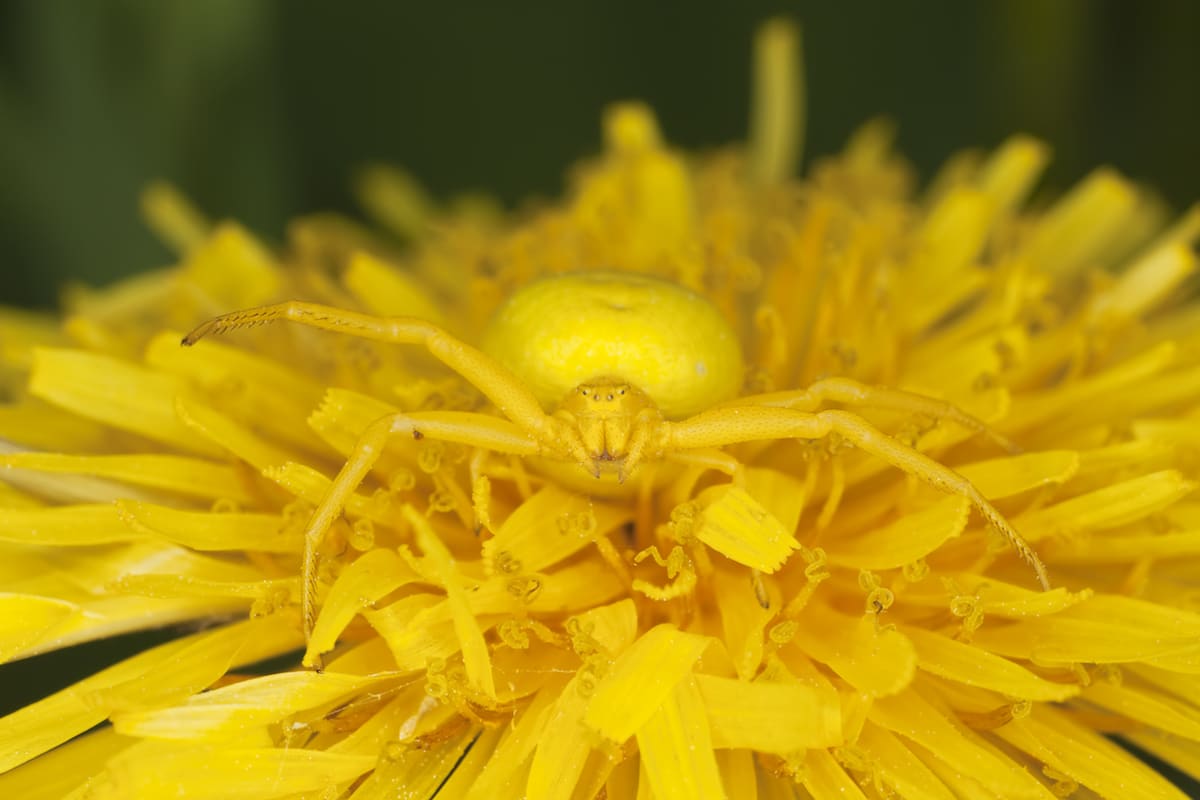
Goldenrod Crab Spider
The Goldenrod Crab Spider is a master of camouflage, using it both defensively and offensively. If confronted by a predator, it won’t hesitate to bite as a last resort. These spiders are adaptable color changers, adjusting their hue over several days to blend seamlessly with their surroundings. So, a vivid yellow spider one day might appear pale green a week later.
This species is an ambush predator, eschewing web-spinning for a more hands-on approach. Positioned at the heart of a flower, ideally a yellow Goldenrod bloom, the spider patiently waits for a bee or butterfly to collect pollen. When the unsuspecting prey draws near, the spider springs into action, swiftly grasping it with its remarkably long front legs before delivering a paralyzing bite. These legs are the spider’s secret weapon, allowing it to capture insects much larger than itself, often giving it a distinctive crab-like appearance. After mating, a female lays an egg sac, typically beneath a leaf, diligently guarding it until the spiderlings hatch approximately three weeks later, at which point she succumbs to nature’s cycle.
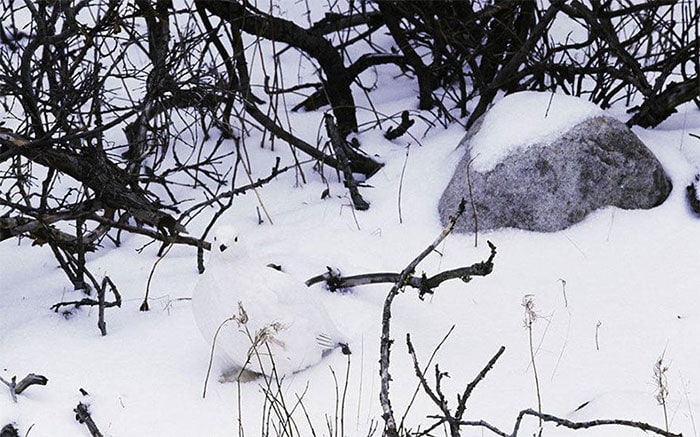
Willow Ptarmigan
The Willow Ptarmigan is a true artist of disguise, showcasing a remarkable transformation throughout the seasons. During the winter, it dons a pristine snowy white plumage, blending seamlessly with its icy surroundings. However, in the warmer summer months, this rotund grouse undergoes a striking makeover, transitioning into a complex palette of reds and browns.
What sets the Willow Ptarmigan apart is its year-round residence in subarctic tundra regions, where many other bird species can only endure the milder seasons. This avian marvel not only survives but thrives in the harsh subarctic environment, utilizing its chameleon-like camouflage to remain concealed from predators and to adapt to the ever-changing colors of its habitat. Truly, the Willow Ptarmigan stands as a testament to nature’s ingenious adaptations and the resilience of life in challenging landscapes.
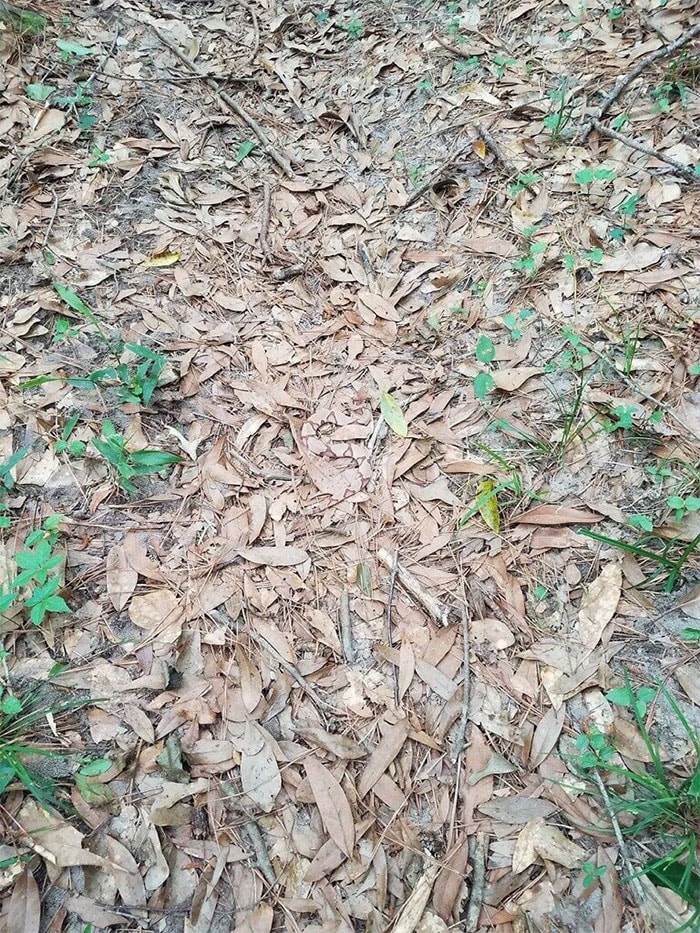
Copperheads (Yes, There IS One In This Photo)
Copperheads, a group of venomous pit vipers, are native to North America and are known for their distinctive appearance and potent venom. These snakes typically have a coppery or reddish-brown coloration, with hourglass-shaped patterns along their bodies. This pattern serves as an effective form of camouflage in their natural habitats, which often include woodlands, forests, and grassy regions. Copperheads are relatively small snakes, typically growing to lengths of 2 to 3 feet. They have heat-sensing pits on their heads, which help them detect prey, even in low light conditions.
While copperheads are venomous, their bites are rarely fatal to humans, and they are generally not aggressive. They would rather rely on their camouflage to hide from potential threats rather than engage in confrontation. These snakes are primarily ambush predators, lying in wait for prey to come within striking distance. Their diet primarily consists of small mammals, amphibians, and insects. Copperheads are fascinating creatures, showcasing nature’s intricate balance between survival strategies and the crucial role they play in the ecosystems they inhabit.
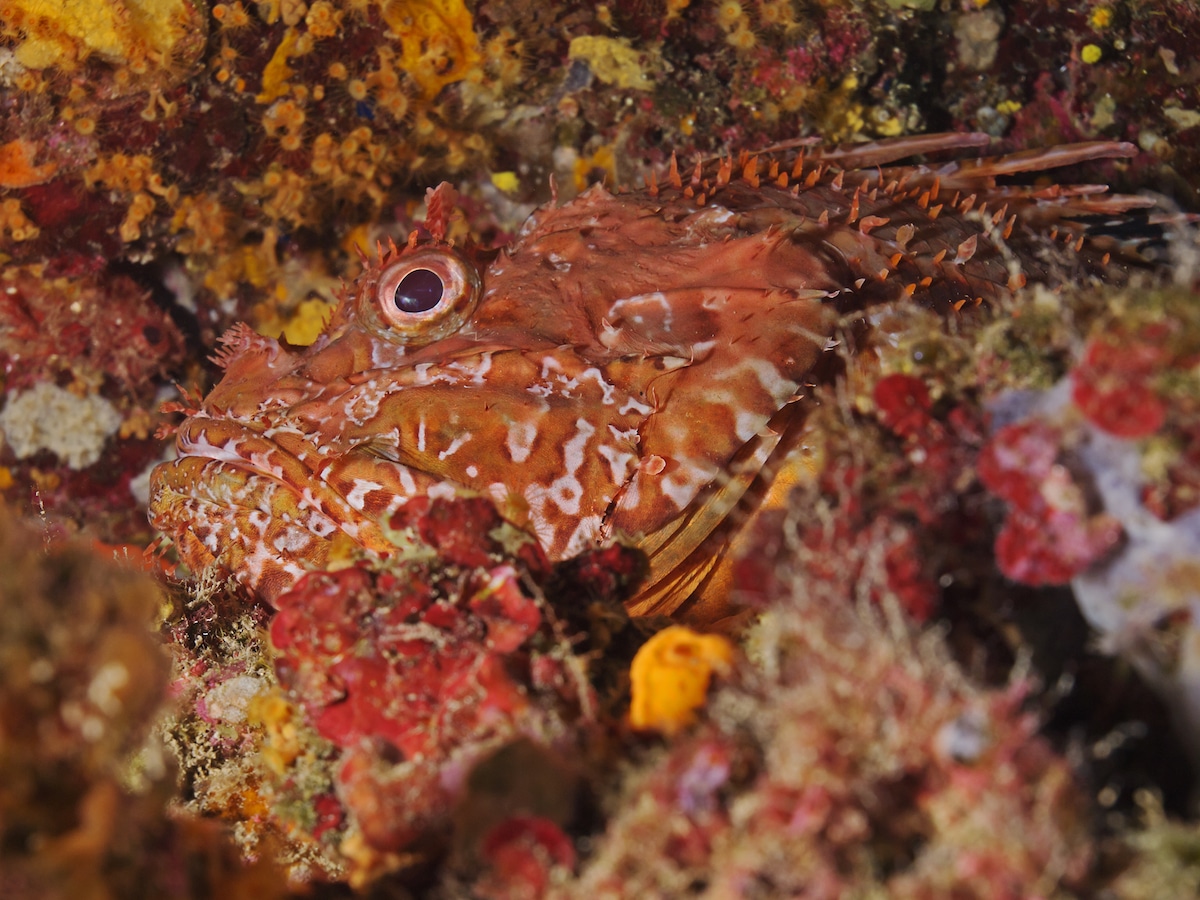
Stonefish
The Stonefish, a true master of disguise, is one of the most venomous fish species in the world. Hailing from the Indo-Pacific region, it is renowned for its exceptional camouflage abilities. Its name is a nod to its appearance, as it closely resembles a rock or a lump of coral on the ocean floor. This deceptive camouflage allows it to lie in wait, nearly invisible to both predators and prey.
Equipped with thirteen venomous spines along its dorsal fin, the Stonefish poses a serious threat to anyone who accidentally steps on or handles it. Its venom contains a potent cocktail of neurotoxins that can cause extreme pain, tissue necrosis, and even paralysis in humans. Despite its menacing reputation, Stonefish play a vital role in marine ecosystems as apex predators, helping to control the populations of smaller fish and maintaining the balance of their underwater habitats. Encounters with these cryptic creatures are a stark reminder of the hidden dangers lurking beneath the waves in the world’s oceans.
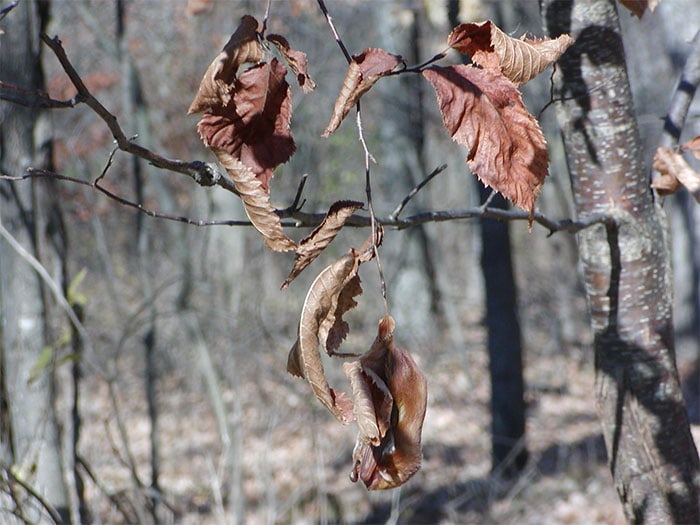
Eastern Red Bat
The Eastern Red Bat, a fascinating creature of the night, is a small to medium-sized bat species found in North and South America. This bat is named for its striking reddish or chestnut-colored fur, making it easily distinguishable from other bat species. Although they are primarily nocturnal, Eastern Red Bats can also be seen during the day, often roosting in trees or shrubs. What makes the Eastern Red Bat particularly intriguing is its remarkable camouflage. During the day, they hang from tree branches and blend in seamlessly with the foliage thanks to their rich, red fur, which closely resembles autumn leaves.
When disturbed, they may expand their wings, revealing a contrasting white underbelly. At night, their red fur serves as an effective disguise against the dimly lit sky. These bats are skilled insect hunters, capturing prey on the wing using echolocation. They primarily feed on moths and other flying insects, making them valuable contributors to natural pest control. Eastern Red Bats are a testament to the diversity and adaptability of North American bat species, embodying the intricate relationship between their unique characteristics and their role in their ecosystems.
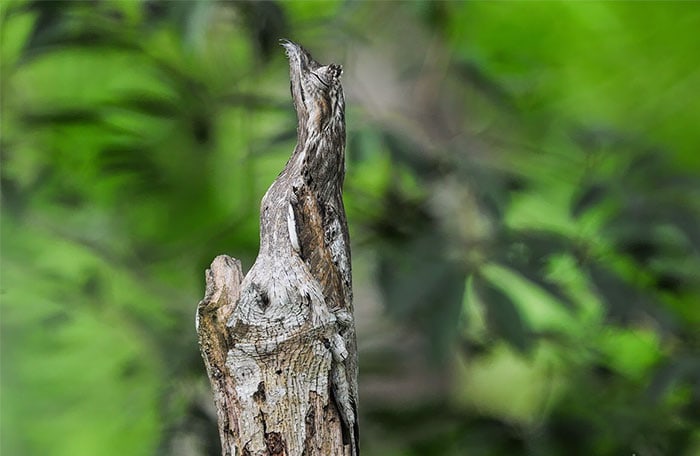
Long-Tailed Potoo
The long-tailed potoo, a captivating nocturnal bird, is native to mainland South America, gracing nearly every country on the continent except Chile and Uruguay. This enigmatic species showcases remarkable diversity with its three subspecies, each possessing unique characteristics. Measuring between 42 to 58 cm in length, the long-tailed potoo flaunts a splendid coat. The nominate subspecies features tawny brown upperparts adorned with buff spots and speckles, while the mantle, back, and rump sport mottled brown and buff patterns. However, what truly sets this bird apart is its ingenious use of camouflage, allowing it to blend seamlessly into its surroundings, whether it be the lush forests of Amazonia or the dry woodlands of Argentina.
A true night owl, the long-tailed potoo feeds on flying insects with grace and agility. During the day, it seeks refuge on dead branches or stubs, perched up to 20 meters above the ground. Nesting is a unique affair, with the species laying a single egg on a stump or branch. The long-tailed potoo serenades the night with soft, undulating calls, often accompanied by owl-like hoots or woof notes. While it may face challenges due to habitat loss in regions like Amazonia, it currently holds the status of “Least Concern” on the IUCN’s list.

Leafy Sea Dragon
Leafy sea dragons earn their common name from the enchanting leaf-like appendages that adorn their bodies. These remarkable creatures possess more of these leafy protrusions compared to their close relatives, the weedy sea dragons. Both species share an uncanny resemblance to floating pieces of seaweed, a brilliant adaptation that conceals them from potential predators in their natural underwater habitat. Leafy seadragons typically reach a total length of about 35 cm. These masterfully camouflaged fishes belong to the same family as seahorses and pipefishes, known as Syngnathidae, and are exclusive residents of Australia’s temperate waters.
Their distribution is limited to the southern coastline of Australia, stretching from Kangaroo Island in South Australia to Rottnest Island in Western Australia. Leafy seadragons make their homes over sandy patches amidst kelp-covered rocks below the low tide line, at depths ranging from approximately 3 to 50 meters. One of nature’s most captivating examples of camouflage, the leafy seadragon boasts a long, pipe-like snout with a petite terminal mouth. Its diet primarily consists of plankton, mysids, and other small crustaceans. What truly sets the leafy seadragon apart is its extraordinary ability to remain incognito; neither its prey nor its potential predators recognize it as a fish, making it a mesmerizing marvel of the underwater world.
